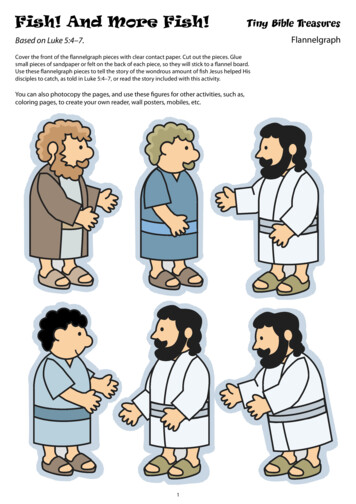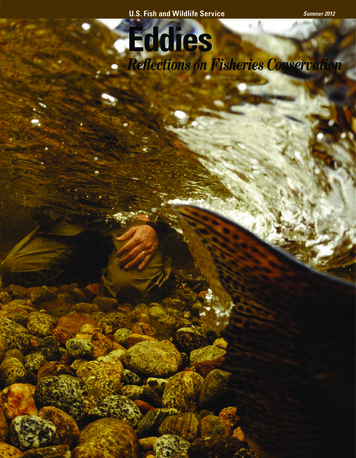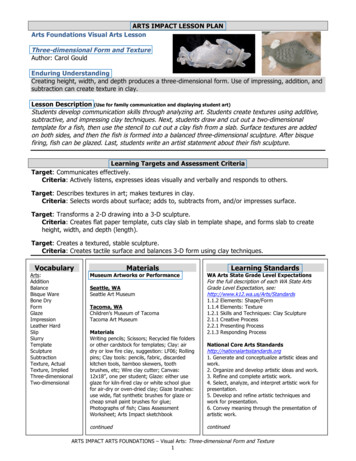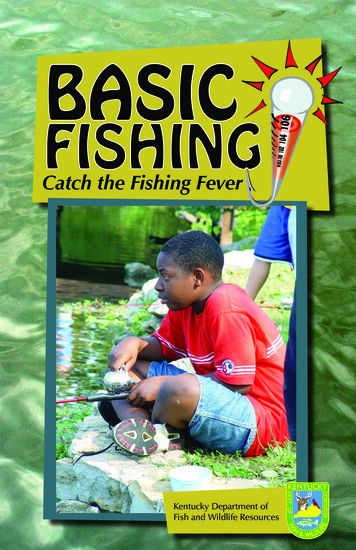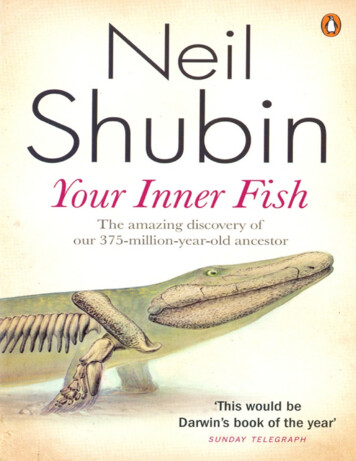
Transcription
2
CONTENTSTitle PageDedicationPrefaceONE Finding Your Inner FishTWO Getting a GripTHREE Handy GenesFOUR Teeth EverywhereFIVE Getting AheadSIX The Best-Laid (Body) PlansSEVEN Adventures in BodybuildingEIGHT Making ScentsNINE VisionTEN EarsELEVEN The Meaning of It AllEpilogueNotes, References, and Further ReadingAcknowledgmentsCopyright3
TO MICHELE4
PREFACEThis book grew out of an extraordinary circumstance in mylife. On account of faculty departures, I ended up directingthe human anatomy course at the medical school of theUniversity of Chicago. Anatomy is the course during whichnervous first-year medical students dissect humancadavers while learning the names and organization ofmost of the organs, holes, nerves, and vessels in the body.This is their grand entrance to the world of medicine, aformative experience on their path to becoming physicians.At first glance, you couldn’t have imagined a worsecandidate for the job of training the next generation ofdoctors: I’m a paleontologist who has spent most of hiscareer working on fish.It turns out that being a paleontologist is a hugeadvantage in teaching human anatomy. Why? The best roadmaps to human bodies lie in the bodies of other animals.The simplest way to teach students the nerves in thehuman head is to show them the state of affairs in sharks.The easiest road map to their limbs lies in fish. Reptiles area real help with the structure of the brain. The reason is that5
the bodies of these creatures are often simpler versions ofours.During the summer of my second year leading the course,working in the Arctic, my colleagues and I discovered fossilfish that gave us powerful new insights into the invasion ofland by fish over 375 million years ago. That discovery andmy foray into teaching human anatomy led me to explore aprofound connection. That exploration became this book.6
CHAPTER ONEFINDING YOUR INNER FISHTypical summers of my adult life are spent in snow andsleet, cracking rocks on cliffs well north of the Arctic Circle.Most of the time I freeze, get blisters, and find absolutelynothing. But if I have any luck, I find ancient fish bones. Thatmay not sound like buried treasure to most people, but tome it is more valuable than gold.Ancient fish bones can be a path to knowledge about whowe are and how we got that way. We learn about our ownbodies in seemingly bizarre places, ranging from the fossilsof worms and fish recovered from rocks from around theworld to the DNA in virtually every animal alive on earthtoday. But that does not explain my confidence about whyskeletal remains from the past—and the remains of fish, noless—offer clues about the fundamental structure of ourbodies.How can we visualize events that happened millions and,in many cases, billions of years ago? Unfortunately, therewere no eyewitnesses; none of us was around. In fact,nothing that talks or has a mouth or even a head was7
around for most of this time. Even worse, the animals thatexisted back then have been dead and buried for so longtheir bodies are only rarely preserved. If you consider thatover 99 percent of all species that ever lived are nowextinct, that only a very small fraction are preserved asfossils, and that an even smaller fraction still are ever found,then any attempt to see our past seems doomed from thestart.DIGGING FOSSILS—SEEING OURSELVESI first saw one of our inner fish on a snowy July afternoonwhile studying 375-million-year-old rocks on EllesmereIsland, at a latitude about 80 degrees north. My colleaguesand I had traveled up to this desolate part of the world totry to discover one of the key stages in the shift from fish toland-living animals. Sticking out of the rocks was the snoutof a fish. And not just any fish: a fish with a flat head. Oncewe saw the flat head we knew we were on to something. Ifmore of this skeleton were found inside the cliff, it wouldreveal the early stages in the history of our skull, our neck,even our limbs.What did a flat head tell me about the shift from sea toland? More relevant to my personal safety and comfort, whywas I in the Arctic and not in Hawaii? The answers to thesequestions lie in the story of how we find fossils and how weuse them to decipher our own past.8
Fossils are one of the major lines of evidence that we useto understand ourselves. (Genes and embryos are others,which I will discuss later.) Most people do not know thatfinding fossils is something we can often do with surprisingprecision and predictability. We work at home to maximizeour chances of success in the field. Then we let luck takeover.The paradoxical relationship between planning andchance is best described by Dwight D. Eisenhower’s famousremark about warfare: “In preparing for battle, I have foundthat planning is essential, but plans are useless.” Thiscaptures field paleontology in a nutshell. We make all kindsof plans to get us to promising fossil sites. Once we’re there,the entire field plan may be thrown out the window. Factson the ground can change our best-laid plans.Yet we can design expeditions to answer specificscientific questions. Using a few simple ideas, which I’ll talkabout below, we can predict where important fossils mightbe found. Of course, we are not successful 100 percent ofthe time, but we strike it rich often enough to make thingsinteresting. I have made a career out of doing just that:finding early mammals to answer questions of mammalorigins, the earliest frogs to answer questions of frogorigins, and some of the earliest limbed animals tounderstand the origins of land-living animals.In many ways, field paleontologists have a significantlyeasier time finding new sites today than we ever did before.We know more about the geology of local areas, thanks to9
the geological exploration undertaken by localgovernments and oil and gas companies. The Internet givesus rapid access to maps, survey information, and aerialphotos. I can even scan your backyard for promising fossilsites right from my laptop. To top it off, imaging andradiographic devices can see through some kinds of rockand allow us to visualize the bones inside.Despite these advances, the hunt for the importantfossils is much what it was a hundred years ago.Paleontologists still need to look at rock—literally to crawlover it—and the fossils within must often be removed byhand. So many decisions need to be made whenprospecting for and removing fossil bone that theseprocesses are difficult to automate. Besides, looking at amonitor screen to find fossils would never be nearly asmuch fun as actually digging for them.What makes this tricky is that fossil sites are rare. Tomaximize our odds of success, we look for the convergenceof three things. We look for places that have rocks of theright age, rocks of the right type to preserve fossils, androcks that are exposed at the surface. There is anotherfactor: serendipity. That I will show by example.Our example will show us one of the great transitions inthe history of life: the invasion of land by fish. For billions ofyears, all life lived only in water. Then, as of about 365million years ago, creatures also inhabited land. Life inthese two environments is radically different. Breathing inwater requires very different organs than breathing in air.10
The same is true for excretion, feeding, and moving about. Awhole new kind of body had to arise. At first glance, thedivide between the two environments appears almostunbridgeable. But everything changes when we look at theevidence; what looks impossible actually happened.In seeking rocks of the right age, we have a remarkablefact on our side. The fossils in the rocks of the world are notarranged at random. Where they sit, and what lies insidethem, is most definitely ordered, and we can use this orderto design our expeditions. Billions of years of change haveleft layer upon layer of different kinds of rock in the earth.The working assumption, which is easy to test, is that rockson the top are younger than rocks on the bottom; this isusually true in areas that have a straightforward, layer-cakearrangement (think the Grand Canyon). But movements ofthe earth’s crust can cause faults that shift the position ofthe layers, putting older rocks on top of younger ones.Fortunately, once the positions of these faults arerecognized, we can often piece the original sequence oflayers back together.The fossils inside these rock layers also follow aprogression, with lower layers containing species entirelydifferent from those in the layers above. If we could quarrya single column of rock that contained the entire history oflife, we would find an extraordinary range of fossils. Thelowest layers would contain little visible evidence of life.Layers above them would contain impressions of a diverseset of jellyfish-like things. Layers still higher would have11
creatures with skeletons, appendages, and various organs,such as eyes. Above those would be layers with the firstanimals to have backbones. And so on. The layers with thefirst people would be found higher still. Of course, a singlecolumn containing the entirety of earth history does notexist. Rather, the rocks in each location on earth representonly a small sliver of time. To get the whole picture, weneed to put the pieces together by comparing the rocksthemselves and the fossils inside them, much as if workinga giant jigsaw puzzle.That a column of rocks has a progression of fossil speciesprobably comes as no surprise. Less obvious is that we canmake detailed predictions about what the species in eachlayer might actually look like by comparing them withspecies of animals that are alive today; this informationhelps us to predict the kinds of fossils we will find in ancientrock layers. In fact, the fossil sequences in the world’s rockscan be predicted by comparing ourselves with the animalsat our local zoo or aquarium.How can a walk through the zoo help us predict where weshould look in the rocks to find important fossils? A zoooffers a great variety of creatures that are all distinct inmany ways. But let’s not focus on what makes themdistinct; to pull off our prediction, we need to focus on whatdifferent creatures share. We can then use the featurescommon to all species to identify groups of creatures withsimilar traits. All the living things can be organized andarranged like a set of Russian nesting dolls, with smaller12
groups of animals comprised in bigger groups of animals.When we do this, we discover something very fundamentalabout nature.Every species in the zoo and the aquarium has a head andtwo eyes. Call these species “Everythings.” A subset of thecreatures with a head and two eyes has limbs. Call thelimbed species “Everythings with limbs.” A subset of theseheaded and limbed creatures has a huge brain, walks ontwo feet, and speaks. That subset is us, humans. We could,of course, use this way of categorizing things to make manymore subsets, but even this threefold division haspredictive power.The fossils inside the rocks of the world generally followthis order, and we can put it to use in designing newexpeditions. To use the example above, the first member ofthe group “Everythings,” a creature with a head and twoeyes, is found in the fossil record well before the first“Everything with limbs.” More precisely, the first fish (acard-carrying member of the “Everythings”) appears beforethe first amphibian (an “Everything with limbs”).Obviously, we refine this by looking at more kinds ofanimals and many more characteristics that groups of themshare, as well as by assessing the actual age of the rocksthemselves.In our labs, we do exactly this type of analysis withthousands upon thousands of characteristics and species.We look at every bit of anatomy we can, and often at largechunks of DNA. There is so much data that we often need13
powerful computers to show us the groups within groups.This approach is the foundation of biology, because itenables us to make hypotheses about how creatures arerelated to one another.Besides helping us refine the groupings of life, hundredsof years of fossil collection have produced a vast library, orcatalogue, of the ages of the earth and the life on it. We cannow identify general time periods when major changesoccurred. Interested in the origin of mammals? Go to rocksfrom the period called the Early Mesozoic; geochemistrytells us that these rocks are likely about 210 million yearsold. Interested in the origin of primates? Go higher in therock column, to the Cretaceous period, where rocks areabout 80 million years old.The order of fossils in the world’s rocks is powerfulevidence of our connections to the rest of life. If, digging in600-million-year-old rocks, we found the earliest jellyfishlying next to the skeleton of a woodchuck, then we wouldhave to rewrite our texts. That woodchuck would haveappeared earlier in the fossil record than the first mammal,reptile, or even fish—before even the first worm. Moreover,our ancient woodchuck would tell us that much of what wethink we know about the history of the earth and life on it iswrong. Despite more than 150 years of people looking forfossils—on every continent of earth and in virtually everyrock layer that is accessible—this observation has neverbeen made.14
What we discover on our walk through the zoo mirrorshow fossils are laid out in the rocks of the world.Let’s now return to our problem of how to find relativesof the first fish to walk on land. In our grouping scheme,these creatures are somewhere between the “Everythings”and the “Everythings with limbs.” Map this to what weknow of the rocks, and there is strong geological evidencethat the period from 380 million to 365 million years ago is15
the critical time. The younger rocks in that range, thoseabout 360 million years old, include diverse kinds offossilized animals that we would all recognize asamphibians or reptiles. My colleague Jenny Clack atCambridge University and others have uncoveredamphibians from rocks in Greenland that are about 365million years old. With their necks, their ears, and their fourlegs, they do not look like fish. But in rocks that are about385 million years old, we find whole fish that look like, well,fish. They have fins, conical heads, and scales; and they haveno necks. Given this, it is probably no great surprise that weshould focus on rocks about 375 million years old to findevidence of the transition between fish and land-livinganimals.We have settled on a time period to research, and so haveidentified the layers of the geological column we wish toinvestigate. Now the challenge is to find rocks that wereformed under conditions capable of preserving fossils.Rocks form in different kinds of environments and theseinitial settings leave distinct signatures on the rock layers.Volcanic rocks are mostly out. No fish that we know of canlive in lava. And even if such a fish existed, its fossilizedbones would not survive the superheated conditions inwhich basalts, rhyolites, granites, and other igneous rocksare formed. We can also ignore metamorphic rocks, such asschist and marble, for they have undergone eithersuperheating or extreme pressure since their initialformation. Whatever fossils might have been preserved in16
them have long since disappeared. Ideal to preserve fossilsare sedimentary rocks: limestones, sandstones, silt-stones,and shales. Compared with volcanic and metamorphicrocks, these are formed by more gentle processes, includingthe action of rivers, lakes, and seas. Not only are animalslikely to live in such environments, but the sedimentaryprocesses make these rocks more likely places to preservefossils. For example, in an ocean or lake, particlesconstantly settle out of the water and are deposited on thebottom. Over time, as these particles accumulate, they arecompressed by new, overriding layers. The gradualcompression, coupled with chemical processes happeninginside the rocks over long periods of time, means that anyskeletons contained in the rocks stand a decent chance offossilizing. Similar processes happen in and along streams.The general rule is that the gentler the flow of the stream orriver, the better preserved the fossils.Every rock sitting on the ground has a story to tell: thestory of what the world looked like as that particular rockformed. Inside the rock is evidence of past climates andsurroundings often vastly different from those of today.Sometimes, the disconnect between present and past couldnot be sharper. Take the extreme example of MountEverest, near whose top, at an altitude of over five miles, lierocks from an ancient sea floor. Go to the North Face almostwithin sight of the famous Hillary Step, and you can findfossilized seashells. Similarly, where we work in the Arctic,temperatures can reach minus 40 degrees Fahrenheit in the17
winter. Yet inside some of the region’s rocks are remnantsof an ancient tropical delta, almost like the Amazon:fossilized plants and fish that could have thrived only inwarm, humid locales. The presence of warm-adaptedspecies at what today are extreme altitudes and latitudesattests to how much our planet can change: mountains riseand fall, climates warm and cool, and continents moveabout. Once we come to grips with the vastness of time andthe extraordinary ways our planet has changed, we will bein a position to put this information to use in designing newfossil-hunting expeditions.If we are interested in understanding the origin of limbedanimals, we can now restrict our search to rocks that areroughly 375 million to 380 million years old and that wereformed in oceans, lakes, or streams. Rule out volcanic rocksand metamorphic rocks, and our search image forpromising sites comes into better focus.We are only partly on the way to designing a newexpedition, however. It does us no good if our promisingsedimentary rocks of the right age are buried deep insidethe earth, or if they are covered with grass, or shoppingmalls, or cities. We’d be digging blindly. As you can imagine,drilling a well hole to find a fossil offers a low probability ofsuccess, rather like throwing darts at a dartboard hiddenbehind a closet door.The best places to look are those where we can walk formiles over the rock to discover areas where bones are“weathering out.” Fossil bones are often harder than the18
surrounding rock and so erode at a slightly slower rate andpresent a raised profile on the rock surface. Consequently,we like to walk over bare bedrock, find a smattering ofbones on the surface, then dig in.So here is the trick to designing a new fossil expedition:find rocks that are of the right age, of the right type(sedimentary), and well exposed, and we are in business.Ideal fossil-hunting sites have little soil cover and littlevegetation, and have been subject to few humandisturbances. Is it any surprise that a significant fraction ofdiscoveries happen in desert areas? In the Gobi Desert. Inthe Sahara. In Utah. In Arctic deserts, such as Greenland.This all sounds very logical, but let’s not forgetserendipity. In fact, it was serendipity that put our teamonto the trail of our inner fish. Our first importantdiscoveries didn’t happen in a desert, but along a roadsidein central Pennsylvania where the exposures could hardlyhave been worse. To top it off, we were looking there onlybecause we did not have much money.It takes a lot of money and time to go to Greenland or theSahara Desert. In contrast, a local project doesn’t requirebig research grants, only money for gas and turnpike tolls.These are critical variables for a young graduate student ora newly hired college teacher. When I started my first job inPhiladelphia, the lure was a group of rocks collectivelyknown as the Catskill Formation of Pennsylvania. Thisformation has been extensively studied for over 150 years.Its age was well known and spanned the Late Devonian. In19
addition, its rocks were perfect to preserve early limbedanimals and their closest relatives. To understand this, it isbest to have an image of what Pennsylvania looked likeback in the Devonian. Remove the image of present-dayPhiladelphia, Pittsburgh, or Harrisburg from your mind andthink of the Amazon River delta. There were highlands inthe eastern part of the state. A series of streams runningeast to west drained these mountains, ending in a large seawhere Pittsburgh is today.It is hard to imagine better conditions to find fossils,except that central Pennsylvania is covered in towns,forests, and fields. As for the exposures, they are mostlywhere the Pennsylvania Department of Transportation(PennDOT) has decided to put big roads. When PennDOTbuilds a highway, it blasts. When it blasts, it exposes rock.It’s not always the best exposure, but we take what we canget. With cheap science, you get what you pay for.And then there is also serendipity of a different order: in1993, Ted Daeschler arrived to study paleontology undermy supervision. This partnership was to change both ourlives. Our different temperaments are perfectly matched: Ihave ants in my pants and am always thinking of the nextplace to look; Ted is patient and knows when to sit on a siteto mine it for its riches. Ted and I began a survey of theDevonian rocks of Pennsylvania in hopes of finding newevidence on the origin of limbs. We began by driving tovirtually every large roadcut in the eastern part of the state.To our great surprise, shortly after we began the survey,20
Ted found a marvelous shoulder bone. We named its ownerHynerpeton, a name that translates from Greek as “littlecreeping animal from Hyner.” Hyner, Pennsylvania, is thenearest town. Hynerpeton had a very robust shoulder, whichindicates a creature that likely had very powerfulappendages. Unfortunately, we were never able to find thewhole skeleton of the animal. The exposures were toolimited. By? You guessed it: vegetation, houses, andshopping malls.Along the roads in Pennsylvania, we were looking at anancient river delta, much like the Amazon today. Thestate of Pennsylvania (bottom) with the Devoniantopography mapped above it.21
After the discovery of Hynerpeton and other fossils fromthese rocks, Ted and I were champing at the bit for betterexposed rock. If our entire scientific enterprise was goingto be based on recovering bits and pieces, then we couldaddress only very limited questions. So we took a“textbook” approach, looking for well-exposed rocks of theright age and the right type in desert regions, meaning thatwe wouldn’t have made the biggest discovery of our careersif not for an introductory geology textbook.Originally we were looking at Alaska and the Yukon aspotential venues for a new expedition, largely because ofrelevant discoveries made by other teams. We ended upgetting into a bit of an argument/debate about somegeological esoterica, and in the heat of the moment, one ofus pulled the lucky geology textbook from a desk. Whileriffling through the pages to find out which one of us wasright, we found a diagram. The diagram took our breathaway; it showed everything we were looking for.The argument stopped, and planning for a new fieldexpedition began.On the basis of previous discoveries made in slightlyyounger rocks, we believed that ancient freshwater streamswere the best environment in which to begin our hunt. Thisdiagram showed three areas with Devonian freshwaterrocks, each with a river delta system. First, there is the eastcoast of Greenland. This is home to Jenny Clack’s fossil, avery early creature with limbs and one of the earliestknown tetrapods. Then there is eastern North America,22
where we had already worked, home to Hynerpeton. Andthere is a third area, large and running east–west across theCanadian Arctic. There are no trees, dirt, or cities in theArctic. The chances were good that rocks of the right ageand type would be extremely well exposed.The Canadian Arctic exposures were well known,particularly to the Canadian geologists and paleobotanistswho had already mapped them. In fact, Ashton Embry, theleader of the teams that did much of this work, haddescribed the geology of the Devonian Canadian rocks asidentical in many ways to the geology of Pennsylvania’s.Ted and I were ready to pack our bags the minute we readthis phrase. The lessons we had learned on the highways ofPennsylvania could help us in the High Arctic of Canada.Remarkably, the Arctic rocks are even older than thefossil beds of Greenland and Pennsylvania. So the areaperfectly fit all three of our criteria: age, type, and exposure.Even better, it was unknown to vertebrate paleontologists,and therefore un-prospected for fossils.23
The map that started it all. This map of North Americacaptures what we look for in a nutshell. The differentkinds of shading reflect where Devonian age rocks,whether marine or freshwater, are exposed. Threeareas that were once river deltas are labeled. Modifiedfrom figure 13.1, R. H. Dott and R. L. Batten, Evolution ofthe Earth (New York: McGraw-Hill, 1988). Reproducedwith the permission of The McGraw-Hill Companies.Our new challenges were totally different from those we24
faced in Pennsylvania. Along the highways in Pennsylvania,we risked being hit by the trucks that whizzed by as welooked for fossils. In the Arctic we risked being eaten bypolar bears, running out of food, or being marooned by badweather. No longer could we pack sandwiches in the car anddrive to the fossil beds. We now had to spend at least eightdays planning for every single day spent in the field,because the rocks were accessible only by air and thenearest supply base was 250 miles away. We could fly inonly enough food and supplies for our crew, plus a slendersafety margin. And, most important, the plane’s strictweight limits meant that we could take out only a smallfraction of the fossils that we found. Couple thoselimitations with the short window of time during which wecan actually work in the Arctic every year, and you can seethat the frustrations we faced were completely new anddaunting.Enter my graduate adviser, Dr. Farish A. Jenkins, Jr., fromHarvard. Farish had led expeditions to Greenland for yearsand had the experience necessary to pull this venture off.The team was set. Three academic generations: Ted, myformer student; Farish, my graduate adviser; and I weregoing to march up to the Arctic to try to discover evidenceof the shift from fish to land-living animal.There is no field manual for Arctic paleontology. Wereceived gear recommendations from friends andcolleagues, and we read books—only to realize that nothingcould prepare us for the experience itself. At no time is this25
more sharply felt than when the helicopter drops one off forthe first time in some godforsaken part of the Arctic totallyalone. The first thought is of polar bears. I can’t tell you howmany times I’ve scanned the landscape looking for whitespecks that move. This anxiety can make you see things. Inour first week in the Arctic, one of the crew saw a movingwhite speck. It looked like a polar bear about a quarter mileaway. We scrambled like Keystone Kops for our guns, flares,and whistles until we discovered that our bear was a whiteArctic hare two hundred feet away. With no trees or housesby which to judge distance, you lose perspective in theArctic.The Arctic is a big, empty place. The rocks we wereinterested in are exposed over an area about 1,500kilometers wide. The creatures we were looking for wereabout four feet long. Somehow, we needed to home in on asmall patch of rock that had preserved our fossils.Reviewers of grant proposals can be a ferocious lot; theylight on this kind of difficulty all the time. A reviewer for oneof Farish’s early Arctic grant proposals put it best. As thisreferee wrote in his review of the proposal (not cordially, Imight add), the odds of finding new fossils in the Arcticwere “worse than finding the proverbial needle in thehaystack.”It took us four expeditions to Ellesmere Island over sixyears to find our needle. So much for serendipity.We found what we were looking for by trying, failing, andlearning from our failures. Our first sites, in the 1999 field26
season, were way out in the western part of the Arctic, onMelville Island. We did not know it, but we had beendropped off on the edge of an ancient ocean. The rocks wereloaded with fossils, and we found many different kinds offish. The problem was that they all seemed to be deepwater creatures, not the kind we would expect to find in theshallow streams or lakes that gave rise to land-livinganimals. Using Ashton Embry’s geological analysis, in 2000we decided to move the expedition east to Ellesmere Island,because there the rocks would contain ancient streambeds.It did not take long for us to begin finding pieces of fishbones about the size of a quarter preserved as fossils.Our camp (top) looks tiny in the vastness of thelandscape. My summer home (bottom) is a small tent,27
usually surrounded by piles of rocks to protect it fromfifty-mile-per-hour winds. Photographs by the author.The real breakthrough came toward the end of the fieldseason in 2000. It was just before dinner, about a weekbefore our scheduled pickup to return home. The crew hadcome back to camp, and we were involved in our earlyevening activities: organizing the day’s collections,preparing field notes, and beginning to assemble dinner.Jason Downs, then a college undergraduate eager to learnpaleontology, hadn’t returned to camp on time. This is acause for worry, as we typically go out in teams; or if weseparate, we give each other a definite schedule of when wewill make contact again. With polar bears in the area andfierce storms that can roll in unexpectedly, we do not takeany chances. I remember sitting in the main tent with thecrew, the worry about Jason building with each passingmoment. As we began to concoct a search plan, I heard thezipper on the tent open. At first all I saw was Jason’s head.He
while studying 375-million-year-old rocks on Ellesmere Island, at a latitude about 80 degrees north. My colleagues and I had traveled up to this desolate part of the world to try to discover one of the key stages in the shift from fish to land-living animals. Sticking out of the rocks was the snout of a fish. And not just any fish: a fish with .File Size: 2MBPage Count: 296Explore furtherWhat Type Of Fish Am I? - Quiz - Quizony.comwww.quizony.com15 Most Beautiful Fish in the World (You Can Keep In Your .www.fishkeepingworld.com10 Fish That Can Live In Both Freshwater & Saltwaterwhatdewhat.comA Complete List of the Different Types of Fish - Animal Sakeanimalsake.comList of Fish Species -- Fish Photoswww.oceanlight.comRecommended to you b





